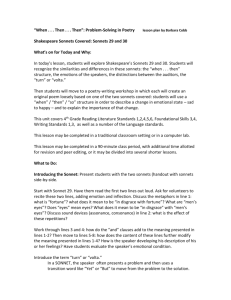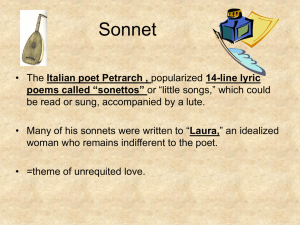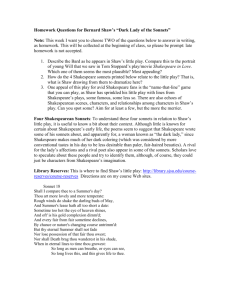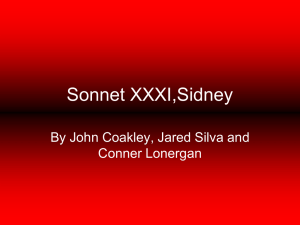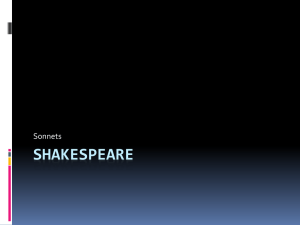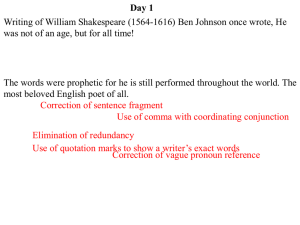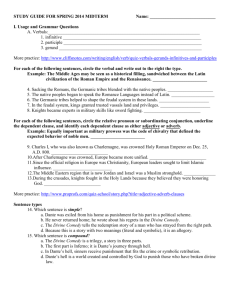Supplementary Table 9
advertisement
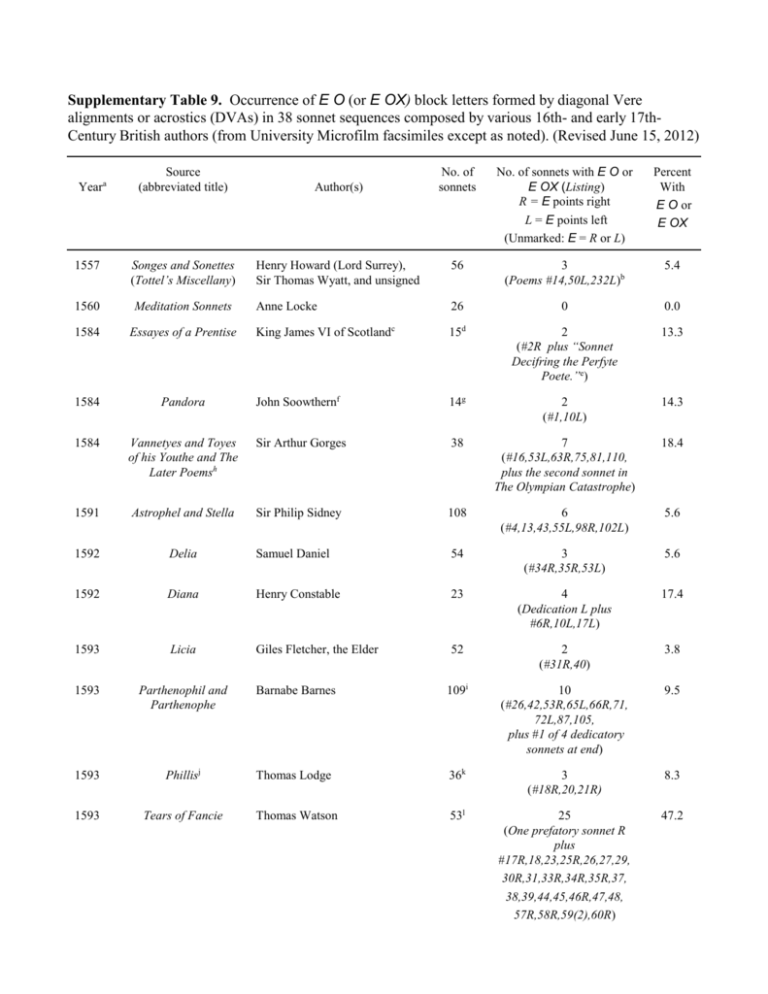
Supplementary Table 9. Occurrence of E O (or E OX) block letters formed by diagonal Vere alignments or acrostics (DVAs) in 38 sonnet sequences composed by various 16th- and early 17thCentury British authors (from University Microfilm facsimiles except as noted). (Revised June 15, 2012) No. of sonnets No. of sonnets with E O or E OX (Listing) R = E points right L = E points left (Unmarked: E = R or L) Percent With E O or E OX Henry Howard (Lord Surrey), Sir Thomas Wyatt, and unsigned 56 3 (Poems #14,50L,232L)b 5.4 Anne Locke 26 0 0.0 King James VI of Scotlandc 15d 2 (#2R plus “Sonnet Decifring the Perfyte Poete.”e) 13.3 Pandora John Soowthernf 14g 2 (#1,10L) 14.3 1584 Vannetyes and Toyes of his Youthe and The Later Poemsh Sir Arthur Gorges 38 7 (#16,53L,63R,75,81,110, plus the second sonnet in The Olympian Catastrophe) 18.4 1591 Astrophel and Stella Sir Philip Sidney 108 6 (#4,13,43,55L,98R,102L) 5.6 1592 Delia Samuel Daniel 54 3 (#34R,35R,53L) 5.6 1592 Diana Henry Constable 23 4 (Dedication L plus #6R,10L,17L) 17.4 1593 Licia Giles Fletcher, the Elder 52 2 (#31R,40) 3.8 1593 Parthenophil and Parthenophe Barnabe Barnes 109i 10 (#26,42,53R,65L,66R,71, 72L,87,105, plus #1 of 4 dedicatory sonnets at end) 9.5 1593 Phillisj Thomas Lodge 36k 3 (#18R,20,21R) 8.3 1593 Tears of Fancie Thomas Watson 53l 25 (One prefatory sonnet R plus #17R,18,23,25R,26,27,29, 30R,31,33R,34R,35R,37, 38,39,44,45,46R,47,48, 57R,58R,59(2),60R) 47.2 Source (abbreviated title) Author(s) 1557 Songes and Sonettes (Tottel’s Miscellany) 1560 Meditation Sonnets 1584 Essayes of a Prentise 1584 Yeara Supplementary Table 9. (continued) Yeara 2 No. of sonnets No. of sonnets with E O or E OX (Listing) R = E points right L = E points left (Unmarked: E = R or L) Percent With E O or E OX William Percy 20 0 0.0 Michael Drayton 52 2 (Amours #27R, 34R) 3.8 Source (abbreviated title) Author(s) 1594 Coelia 1594 Ideas Mirrour 1594 Zepheria Anonymous 35m 3 (Canzones #20,30L,39R) 8.6 1595 Amoretti Edmund Spenser 89 8 (#2,15R,21,39,55, 64L,81,88) 9.0 1595 Cynthia Richard Barnfield 20 1 (#5) 5.0 1595 Divine Centurie Barnabe Barnes 100 7 (#2,3,18,20R,64, 83R,96) 7.0 1595 Emaricdulfen E.C. Esquire 40 19 (#4,6,7,9R,10,13R,19R, 23,24R,25R,27R,28,29, 30,33,36,37,38,40) 47.5 1595 Epithalamiono Sir John Davies 10 2 (Clio, Polyhimnia L) 20.0 1595 Ovid’s Banquet George Chapman 10 0 0.0 1596 Chlorisp William Smith 52 7 (2 dedicatory sonnets Plus #23,24,36L,42L,46) 13.5 1596 Diellaq R.L. Gentleman (= Richard Lynche?) 38 16 (#1,3,4,5,11,14,16,21,23, 24,25,26,27,30,33,34R) 42.1 1596 Fidessa Bartholomew Griffin 62 9 (#6,11,17R,19R,23,27, 31L,52,56L) 14.5 1597 Dedicatory Sonnetsr Henry Lok 60 8 (#11,12,16,17,21, 23,27L,29)s 13.3 1597 Gullinge Sonnetso Sir John Davies 10t 2 (#5,9R) 20.0 1597 Poemsu Sir John Salusbury 24 2 (Sonetto #21,23) 8.3 Supplementary Table 9. (continued) Yeara Source (abbreviated title) 3 Author(s) No. of sonnets No. of sonnets with E O or E OX (Listing) R = E points right L = E points left (Unmarked: E = R or L) Percent With E O or E OX 1598 Celestiall Elegies & Funerall Lamentacions Thomas Rogers 41 5 (Elegy quatorzains #1L, 15; Maji Sonnet R; Author’s conclusion L; Funeral quatorzain #4L) 12.2 1598 Certain Sonnets Sir Philip Sidney 14 0 0.0 1602 Idea Michael Drayton 67 5 (#4,44R,46,58,66) 7.5 1604 Aurora Sir William Alexander 105v 7 (#6,31,40,42R,79L, 94R,97) 6.7 1605w Wittes Pilgrimage John Davies of Hereford 103 4 (#10R,15,20R,51L) 3.9 1606 Amorose Songes, Sonets, and Elegies Alexander Craig 94x 4 (#1,2,21R,44R) 4.3 1611 Caelia Sonets David Murray 27y 1 (#2) 3.7 1616 Coeliaz William Browne 14 3 (#9,12,13) 21.4 1616 Poems (Parts I and II) William Drummond of Hawthornden 84aa 5 (#2R,20,45L,55R plus “When with brave Arte...”L) 6.0 1633 Holy Sonnets in Poems by J.D.bb John Donne 26cc 0 0.0 1633 The Temple George Herbert 15 2 (H. Bapt. L plus Love #2R) 13.3 Totals: 1796 189 (10.54%) % Ave.: SD (pop): 11.59 11.57 Notes to Supplementary Table 9. Notes: a Year of initial publication or estimated date of MS. As numbered in Tottel’s Miscellany (1557–1587), Revised Edition, edited by Hyder E. Rollins (Harvard University Press, Cambridge, Mass., 1966). b c Afterward, King James I of England. His authorship is indicated in a Latin 12-line prefatory ACROSTICHON spelling IACOBVS SExTVS. d e Includes three sonnets not in the numbered first twelve. With two sets of ERd O block letters formed by 16 of the 20 DVAs that are present. f A pen name of Captain Morrys Denys according to Charles Wisner Barrell (Shakespeare Fellowship News Letter, October 1943). Includes a “Sonnet to the Reader”and 13 sonnets “To his Mystresse Diana”, but excluding “Foure Epytaphes made by the Countes of Oxenford” and one “Epitaph made by the Queenes Maiestie”. g h Printed transcriptions from the Egerton MS 3561 in The Poems of Sir Arthur Gorges edited by Helen E. Sandison (Oxford, 1953). Incudes, besides the twenty-nine 14-line sonnets in Vannetyes and Toyes, four such sonnets in The Later Poems (1599–1614) and five in The Olympian Catastrophe (1612). i Includes 26 sonnets with 15 lines. As apparently first observed by Joseph Sobran (“Before He Was Shakespeare: Part Two,” The Shakespeare Oxford Newsletter, Spring 2005), various lines and passages in Phillis are repeated verbatim or closely imitated in the later sonnet sequence Chloris (1596) by William Smith. j k Includes two “sonnets” with 12 lines (# 8 and #26), one sonnet with 15 lines (#17), and one sonnet with 16 lines (#12). Includes one prefatory sonnet and two 18-line “sonnets.” Published the year after Watson’s death, this Tears of Fancie (or Love Disdained) sonnet collection contains numerous “borrowings” from A Hundreth Sundrie Flowres (1573) and other sources. Sonnets #9 through #16 are missing in surviving copies. Sonnet #60 is known from MS evidence to be by the Earl of Oxford. The first lines of the 25 sonnets with E O block letters formed by DVAs are given in Supplementary Table 9A, where 11 have unequivocal ER orientations and 14 have ER/L orientations, but none have EL orientations. l m Includes two sonnets with 15 lines (#23 and 35) but excludes five canzones with 16 or more lines (#1,2, 24, 36, and 40). As pointed out by Michael Brame and Galina Popova in Chapter 11 of their Shakespeare’s Fingerprints (Adonis Editions, Vashon Island, WA, 2002) and by Joseph Sobran (“Before He Was Shakespeare: Part One,” The Shakespeare Oxford Newsletter, Winter 2005), the phraseology and syntax of many of the Emaricdulfe sonnets bear strong resemblances and congruencies with many passages in SHAKE-SPEARES SONNETS (1609) and other works of Shakespeare. Although written in the English style rhyme scheme, these sonnets, unlike the original edition of Shakespeare’s, were printed in alternating line indentations. The first lines of the 19 sonnets with E O block letters are given in Supplementary Table 9B, where 13 have ER/L orientations and 6 have ER orientations, but none has an EL orientation. n 4 Notes to Supplementary Table 9. (continued) o Printed transcription from MSS in The Poems of Sir John Davies, edited by Robert Krueger (Oxford, 1975). The holograph copy of the Gullinge Sonnets in the Chetham Hospital and Library MS A.4.15 (8012), published in English and Scottish Sonnet Sequences of the Renaissance, edited by Holger M. Klein (Georg Olms Verlag, 1984, Vol. 1, pp. 271-283), has the same DVA alignments as the Krueger transcription. The date of composition of the Gullinge Sonnets is uncertain, but it may have been as early as 1595 when Emaricdulfe appeared, since that name appears in one of them. p As mentioned in Note j above, many lines and passages in these Chloris sonnets of 1596 first appeared in Phillis (1593) by Thomas Lodge. q The phraseology, imagery, allusions to nature, repetitions of words, and other characteristics of the Diella sonnets are reminiscent of SHAKE-SPEARES SONNETS (1609) and passages in other poems of Shakespeare. Although written in the English style rhyme scheme, these sonnets, unlike those of Shakespeare, were printed with alternating line indentations like those of E.C.’s Emaricdulfe (cf. Note n above). The first lines of the 16 sonnets with E O block letters formed by DVAs are given in Supplementary Table 9C, where 15 have ER/L orientations, and only one has an ER orientation. Sonnets “collected by the Printer” as appended to the 200 “Sundrie Sonets of Christian Passions” following Lok’s paraphrase of Ecclesiastes. r Not numbered in the original printing. No. 12 is dedicated to the “Earle of Oxford.” s t Includes prefatory sonnet to Sir Anthony Cooke. u In SINETES Passions uppon his fortunes ... etc. by Robert Parry, Gent. (London, 1597). Reprinted in Poems by Sir John Salusbury and Robert Chester, published for the Early English Text Society, Vol. 113 (London, 1914). v Sonnet #86 is missing in the microfilm facsimile. w Most likely year of undated publication. x Unnumbered order. In the Hunterian Club printing of 1873 the four EO sonnets appear on pages 25, 26, 45, and 69, respectively. y Includes one opening and four additional dedicatory sonnets at the end. z In The Whole Works of William Browne, Vol. 2, collected and edited by W. Carew Hazlitt. The Roxburghe Library, 1869. Sonnets in “The Second Part” of Drummond’s Poems of 1616 include one from Teares on the Death of Moeliades, nine from Urania, or Spirituall Poems, and six from Madrigals and Epigrammes. aa bb In contrast to Helen Gardner’s dating of the composition of these sonnets to ca. 1607–1611 in her John Donne: The Divine Poems, 2nd ed. (Oxford, 1978), Dennis Flynn in the John Donne Journal (1988, Vol. 7, No. 1, pp. 35–46) presents evidence that at least some of them were written earlier, possibly in the 1590s. Includes four additional “Holy Sonnets” in the edition of 1635 plus three in the Westmoreland MS reprinted by Gardner (see Note bb above). cc 5

